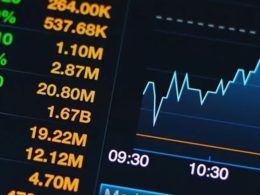by Jurrien Timmer, Director of Global Macro for Fidelity Management & Research Company
Wherever You Go, There You Are
While markets were relatively quiet last week (with the S&P 500 down 0.35% and the 10yr stuck in its range), the same cannot be said for the headlines. It’s a reminder that the financial markets are engaged 24/7 in a never-ending process of price discovery.
“Wherever you go, there you are” is an old saying that reminds us that there is no escape from our reality, no matter how much we try. It’s an apt metaphor for price discovery: no matter how much work we do to come up with that perfect investment thesis, that thesis could change tomorrow and we need to be mentally adaptive enough to go with that flow. As a road warrior, it’s a bit like rolling with the punches when flights get delayed or cancelled. The sooner we accept change instead of fighting, the more at peace we are.
Oh, and happy Father’s Day to my 97 year old dad. Love you Opi, and see you next week!
What Doesn’t Happen Says as Much as What Does
As most technicians know, what doesn’t happen in reaction to news is often more telling than what does happen. When a market is supposed to react a certain way but doesn’t, something is going on. Case in point was Friday’s news out of the middle east. When geopolitical events flare up, typically equities will go risk-off, gold will rally, bond yields will fall, and the dollar will go bid.
But only the first two happened on Friday. Bonds were “unch’d” and the dollar index (DXY) made a new cycle low. This is now the second time that this has happened this year, the first being the reaction to “Liberation Day” in early April.

Something is going on, and in my view an important regime change is underway in which Treasuries and the dollar no longer provide the role as global safe haven for risk markets.
A Changing of the Guard?
The leaderboard below (which shows rolling 3-month returns using weekly data) tells the story: Bitcoin, gold, Mag7, and non-US equities on top, and the dollar and Treasuries at the bottom.

You will notice that CTA’s (managed futures) are also near the bottom. Normally this alternative asset class is low-vol and uncorrelated, but they have gotten whipsawed by the abrupt trend change in April. Trend-driven models don’t do well when trends reverse quickly.
A Tale of Two Tails
Speaking of trend change, the chart below tells that story. The bars show the distribution of 4-week price returns for the S&P 500 since 1925, and the string of dots shows the accompanying 4-week % change. The red dot is where we were on April 4, two days after Liberation Day, and the green dot is April 25. We went from the left tail to the right tail in the span of three weeks.

From V to M?
The price analog below shows that the SPX remains on track in following the best case scenario of a V-shaped recovery. But now that the V is complete, taking us from all-time highs in February to -21.5% in April to now back to within 2% of the highs in June, the question is what happens next.

The above analog measures the index from the point at which it has declined 20%. The chart below measures the drawdown from its start. Here again we see that the recovery has now taken us where few previous cycles have, at least so quickly after the correction. It suggests that the markets need some time to digest the recent gains, especially now that they have priced in a right tail best-case scenario.

Long Live the Cyclical Bull?
Until the S&P 500 makes a string of new all-time high, I am not prepared to conclude that the cyclical bull market that started in October 2022 is still intact. Just as plausible in my view is that a long consolidation has begun, not unlike the 2014-2016 “stealth bear” period (per the chart above). That long holding pattern produced two 15% drawdowns. My guess is that we are forming the upper bound of a prolonged trading range.

Rising Wedge
The breadth and momentum of the recent rally should inform us as to the technical health of this cycle. The daily chart below does not impress in that sense. While the index is closing in on the highs, breadth has been unimpressive and diverging from price, while the price index itself could be forming a rising wedge.

The Dollar’s Fading Hegemony
To me, the price action in the dollar and bonds tells the story of a potentially changing global regime, in which gold, the Euro and the Yen are replacing the USD and Treasuries as the safe haven. Note below that the dollar index (DXY) made a new low on Friday as tensions mounted in the Middle East.
Geopolitics aside, given the rate reset of the past three years, foreign investors now have a plethora of choices when it comes to investing their reserves. The menu has broadened and There Are Many Alternatives (TAMA) now.

Gold: Follow the Liquidity
Gold was bid on Friday, as would be considered normal at times of stress. But while typically these geopolitical rallies might be short-lived, these days it’s par for the course, given the fiscal path that the world is on. The global money supply made yet another new high last week, and is now growing 8.5% year-over-year. Gold can be driven by different factors at different times (from real rates to price inflation to geopolitics), and monetary inflation (excess growth in the money supply) is one of them.

Bitcoin is trying to follow suit, and as the rising Sharpe Ratios show below, both players are on the field right now. But Bitcoin still suffers from its split personality (store of value one day, NASDAQ proxy the next), and Friday was an example of that.

Fork in the Road
Meanwhile, long Treasuries remain at a fork in the road, stuck between following the forward curve lower (as the Fed presumably resumes easing later this year) and following the term premium higher. The bond model below suggests that the former roadmap would take the 10-year down to a range of 3.5% and 4.3%, while the latter would take it higher to a range of 4.2% to 5.5%. For now, we are stuck right in the middle at 4.4%.

Earnings Convergence
Back to equities, an important regime change appears to be underway between US and non-US markets. We all know the valuation story, with US equities trading at a 21x P/E-multiple while the rest of the world is at 15x. That spread has been justified by the superior fundamentals of the S&P 500 (driven by the Mag7), in the form of better earnings, better margins, and higher payouts.
We have all been waiting for that mean reversion to kick in, but that requires a catalyst (in the form of earnings) that until recently had been missing. But a regime change appears to have begun.
Below we can see the markdowns in US earnings estimates in recent months, as analysts priced in modest tariffs. Those estimates are now starting to improve a bit as the market has swung from left tail to right tail.

But look at the estimates below for the MSCI EAFE index. They are being marked up at a significant pace, much more so than US estimates.

The next chart shows both sets of estimates on the same scale. A clear convergence is underway, amplified by the above mentioned valuation spread as well as the falling dollar. TAMA indeed.

Choosing from a Broader Menu
In my view, a balanced portfolio for this new TAMA era consists of assets with high Sharpe Ratios and low correlations to both equities and bonds. Those include gold, Bitcoin, cash-like assets, and alts. Personally, I would place all of those uncorrelated assets in what used to be the 40 bucket (now more like 20/20).
As for the 60, the above-mentioned mean reversion between US and non-US equities is a real opportunity to keep the 60 going, even if the US secular bull market is cresting.

Sharpe vs Sortino
One question that I keep getting asked when discussing Sharpe Ratios (and Bitcoin) is whether it would be better to use Sortino ratios. The Sortino ratio is like the Sharpe ratio, except that it measures the standard deviation of only the negative returns (instead of all returns). So, it measures only the downside volatility, which seems reasonable given that most investors care more about downside vol than upside vol.
Below is a ranking of the asset classes that I track based on the Sortino ratio. There isn’t a huge difference between the two ratios in terms or ranking, but as the Bitcoin bulls frequently point out, bitcoin ranks even higher per the Sortino Ratio as opposed to just the Sharpe Ratio. Market neutral hedge funds take a big step down.

And if we update the periodic table above with a new one that shows the 5-year Sortino ratio (at 3-month intervals), we now see some trends forming. Bitcoin, gold, and absolute return strategies are at the top, and long Treasuries, commodities, MSCI China, and HFRX equity market neutral at the bottom.

1188534.24.0
This information is provided for educational purposes only and is not a recommendation or an offer or solicitation to buy or sell any security or for any investment advisory service. The views expressed are as of the date indicated, based on the information available at that time, and may change based on market or other conditions. Opinions discussed are those of the individual contributor, are subject to change, and do not necessarily represent the views of Fidelity. Fidelity does not assume any duty to update any of the information.
Copyright © Fidelity Investments














